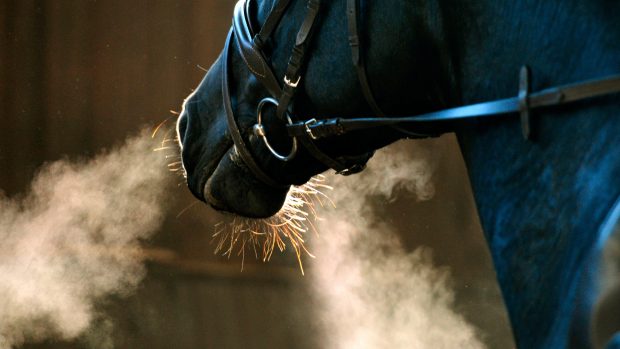Recurrent airway disease (RAD) is a common chronic progressive inflammatory condition of the lower respiratory airways. It has various other names, including chronic obstructive pulmonary disease (COPD), allergic airway disease, equine asthma, stable cough, heaves and broken wind.
RAD is essentially an airway allergy and/or hypersensitivity to inhaled dust particles, particularly from hay and straw, which contain environmental elements (“allergens”) such as fungal spores. These trigger an inflammatory reaction and an accumulation of mucus in lower airways, together with thickening and constriction of the airway walls. The result is a disruption to airflow in the lungs plus varying degrees of difficulty in breathing, resulting in “poor performance” or exercise intolerance.
Although it is primarily a winter disease, more cases tend to be noticed in spring. This is because many RAD-affected horses are at rest over the winter and show few or no signs, and it is not until they are brought up in preparation for the competition season that the problem comes to light.
Predisposing factors of RAD can be put into three categories:
Environmental factors
- Cool, wet climates: horses are more likely to be stabled and bedding and food is more at risk of getting wet and mouldy
- Prolonged stabling with poor ventilation
- Moulds, dust and spores from food
- General cleanliness of yard/air pollution
- Inadequate clearance of staled bedding/deep littering, causing build-up of ammonia fumes
Prior infection
RAD can follow a previous respiratory infection, especially if the stable management is poor or the animal not rested for long enough.
Inheritance
There appears to be a definite genetic susceptibility, possibly due to individual variations in the airway clearance mechanisms. RAD tends to become more common with age, and to reoccur. With each “attack”, or if the allergen source is not removed, further damage can occur to the airways. In addition, affected horses appear to become increasingly sensitive to other stimuli, until one is left with a chronically broken-winded animal, which is extremely difficult to manage.
The signs of RAD range from subtle and sub-clinical through to severe and even life-threatening. They can come on gradually or be very acute. In the mildest cases, horses simply don’t perform to expectation. In the worst, their body becomes starved of oxygen, they lose weight, become cyanotic (turn blue) and even die. These are common signs:
- Afebrile (normal temperature)
- Cough at rest that worsens with exercise; may be soft and persistent or paroxysmal and explosive
- Occasional mucky nasal discharge
- Increased respiratory rate (up to 25 breaths per min, with normal being 8-12bpm)
- Increased, often biphasic (double) expiratory effort, with a visible abdominal effort
- A “heave line”; a visible ridge along the flank due to the muscular effort needed to breathe out
- Audible crackling and wheezing in the lungs
- Flaring of the nostrils
Many cases can be accurately diagnosed simply from the history and the fact that “common things occur commonly”. However, your vet may also want to endoscopically examine the trachea. He or she may even take a sample from the lower airways to check for the presence of inflammatory cells. Sometimes the fact that there is an improvement with treatment is sufficient to confirm a tentative diagnosis.
Recently blood tests aimed at measuring antibody levels to various environmental allergens have become available. But their correlation value, and therefore interpretation, remains questionable at present.
Treatment
The most important aspect of dealing with RAD is how it is managed. Medical treatment can help in the short term, and certainly with acute cases, but, ultimately, maintaining a healthy, dust-free environment is essential.
- Turn out as much as possible
- Feed haylage or another dust-free hay alternative
- Feed pelleted hard food, dampened down just beforehand
- Feed from the floor to encourage mucus drainage from the airways
- Bed on rubber, paper or some other dust-extracted bedding
- Muck out daily
- Move horse away when mucking out or sweeping yard
- Always groom outside
- Improve stable ventilation
- Keep muckheap and hay and straw store well away and preferably downwind
There is a variety of medication available to alleviate the signs of RAD. The two most often used are bronchodilators (for example, Ventipulmin), which relax the muscle walls, decrease mucus viscosity and accelerate its clearance from the airways, thus opening them up, and anti-inflammatories (for example, corticosteroids), which reduce lung inflammation. Other types of medication that can be of use include mucolytics, which break down airway mucus (for example, Sputolosin) and diuretics, which relieve lung congestion (for example, Frusemide).
There are also several “alternative” forms of treatment, including immunotherapy (allergen neutralisation with hyposensitising vaccines) and homeopathy, both of which have anecdotal support but no scientific evidence of efficacy. In-feed supplements containing anti-oxidants, garlic or bio-available sulphur (such as MSM) continue to be popular.
Remember that once a horse has been affected it will remain sensitised and will be likely to react again. Studies have shown that sensitive horses only need to be exposed to dust for 1-2hr for a reaction to be triggered.
Long-term management remains key to the problem and it makes sense to create as healthy an environment as possible, whether your horse coughs or not. Dusty or mouldy hay is probably still the major culprit, and buying the best hay possible is money well spent. I advise soaking hay routinely by submerging it fully for 30-60min because this causes any spores to swell and stick to the hay — then being ingested rather than inhaled. This will only work if the hay is fed wet, rather than allowed to dry out again. Ultimately, dust-free hay alternatives are safer and less labour intensive, albeit more expensive.
- This veterinary feature was first published in Horse & Hound (17 March, ’05)

 Get up to 19 issues FREE
Get up to 19 issues FREE
 UK’s No1 weekly for Horses for Sale
UK’s No1 weekly for Horses for Sale
 Latest results and reports
Latest results and reports
 TO SUBSCRIBE CLICK HERE
TO SUBSCRIBE CLICK HERE




